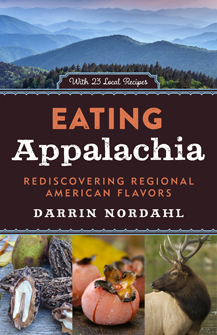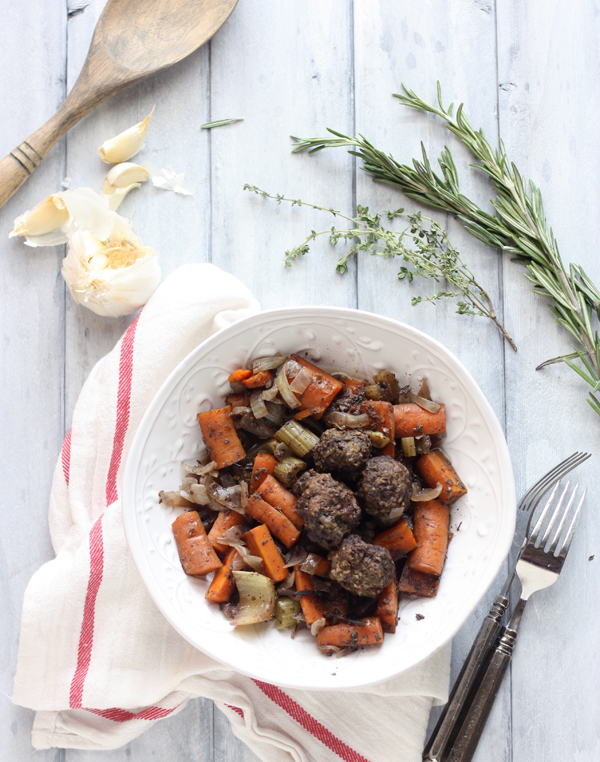Hi! It’s me, Andrew (Kelly’s husband). I’ve been waiting for Eating Appalachia to be published since last fall when I designed the book’s cover. Kelly may have mentioned that I design book covers (and their insides) for a living. Usually the publisher sends me a short description of the book to get a sense of how the cover should look, but it this case they sent me the entire manuscript. I was really into it! This book is what Paleo is all about: a cuisine based on real food that comes from local small farms (or even wild-caught).*
 Eating Appalachia is not a cookbook (although it does include 25 recipes). It’s an enlightening story of Nordahl’s Appalachian travels: meeting farmers and foodies; and discovering their unique foods and food culture. This region is home to a wealth of fruits, vegetables, nuts, and animals (and dishes) that are almost unknown elsewhere.
Eating Appalachia is not a cookbook (although it does include 25 recipes). It’s an enlightening story of Nordahl’s Appalachian travels: meeting farmers and foodies; and discovering their unique foods and food culture. This region is home to a wealth of fruits, vegetables, nuts, and animals (and dishes) that are almost unknown elsewhere.
Have you tasted the sunny flavor of a pawpaw? Probably not, unless you’re a local. These fruits are too fragile to be transported to the rest of the country! How about a hickory nut? They have the opposite problem than the pawpaw—they’re tough. Their shells are so tough that companies don’t bother selling them commercially. Hickory nuts are treat exclusive to the Appalachian locals who put in the time to hammer them open. We also learn about meals made from butternuts, the now-vanished American chestnut (see Kelly’s Chestnut flour biscuit recipe), native persimmons, ramps, sassafras, spicebush berries, sumac berries, elk, and even squirrel!
The publisher and author gave us permission to share this recipe from the book. Aside from cooking a mammoth, what could be more Paleo than elk stew? I think it would also be great with bison (their range historically extended into the Appalachian region).
—Andrew

I made the stew with elk meatballs because I couldn’t find elk steak. (Photo by Kelly)
Chianti-Braised Elk Stew
Ingredients
4 tablespoons grapeseed oil [I would use avocado oil]
1 pound elk round steak
2 cups chopped carrots
3 celery stalks, chopped
1 small yellow onion, chopped
8 cloves garlic, peeled and halved
1/2 stick butter [or ghee]
1 sprig fresh rosemary, plus 4 for garnish
5 large sprigs fresh thyme
2 tablespoons fresh oregano
1 teaspoon crushed red pepper
1/2 cup Chianti (or your favorite dry red wine)
salt and pepper to taste
The book’s directions:
- Preheat the oven to 300°F.
- Begin by searing the elk steak. Heat 2 tablespoons of the grapeseed oil in a large braising pan or sauté pan over medium-high heat. Sear the elk on both sides until nicely browned. Remove the meat from the pan and set on a plate, along with any juices.
- Heat the remaining 2 tablespoons grapeseed oil in the pan and sear the carrots. Then add the celery, cooking a couple minutes longer until softened. Add the onion and cook until it has sufficiently “sweated” and finally add the garlic.
- Now add the butter. When the butter has melted, add in the herbs (rosemary, thyme, oregano, crushed red pepper). Add the red wine and bring to a boil. Cook until the liquid is reduced to about half then season with salt and pepper.
- Return the seared elk steak, along With the juices, to the pan. Place a tight-fitting lid over the pan and set in the pre-heated oven. Let the meat braise for about 2 hours. Remove from the oven and test the meat with a fork; it should begin to pull apart with a light tug.
- Once done, remove the elk from the braise and cut into large bite-sized pieces. Return the meat back to the stew and carefully toss with the vegetables. Ladle into bowls, garnish with a sprig of rosemary, and serve.
Andrew’s alternate directions:
We weren’t able to find elk steak at our local grocery store (stores in Colorado always have elk, buffalo, and other wild game but not so much here in CA). I was able to find ground elk in the freezer section. So! I rolled the elk into balls, I removed the oil and butter, and threw everything else into a slow cooker on high for 4 hours. If I make the meatballs again, I think I’ll season them with a teaspoon of thyme, 1/2 teaspoon of salt, and 1/2 a teaspoon pepper.
* To be clear: the 25 recipes in this book were not intended to be officially Paleo. But I think it’s very easy to make small adjustments and substitutions to fit our diet.
P.S. The publisher of Eating Appalachia is a client of mine, but they did not ask me to review the book. I just really love it and thought you would too.


Avery says
The cover you designed looks great! The recipe looks pretty good too. Fortunately in the Portland, OR area I have access to elk meat… I just don’t know what to do with it. I’ll definitely give this a try when the days start cooling off.
Carolyn says
Glad to clarify this is ELK and not ELF. ;>)
Jamie smith says
So happy to read there weren’t any “elf’s” hurt to make this stew…….hehe
Looking forward to your next book!
Thanks
Kandy says
I have to laugh…in the email sent out it says “Elf” stew….
Courtney says
Oh, thank goodness it is elk stew and not ELF stew, as it stated in your email! I was terribly worried for those poor elves! 😉 This looks wonderful and I am always excited to see a stew recipe that does not include tomatoes! Can’t wait to try it!
Kelly says
Haha! Sorry about that! 🙂 I asked Andy if he wanted to add tomatoes, and he said no!
Sarah in Tehachapi says
OK, So now I know what to make on Christmas Eve. Just tell the kids this is the stew Elves eat at the North Pole. I live in a remote area of CA in the Sierras. Won’t find wild game of any kind in our stores. So beef it is. Looks and sounds good. This is what lodge ware is for.
bob says
Looks like an interesting book; thanks for sharing Andrew. Just a question about the butter though. I think that a stick of butter in Australia is bigger than in the USA – how much ghee should I use?
bob says
I’m also glad to see a stew without tomatoes =)
Kelly says
Half of a US stick of butter would be 4 tablespoons 🙂
bob says
Thanks!